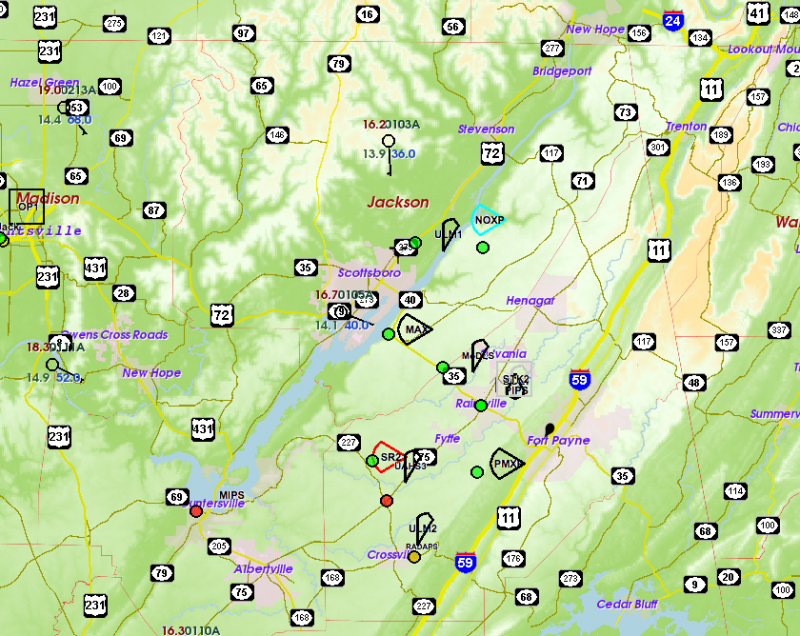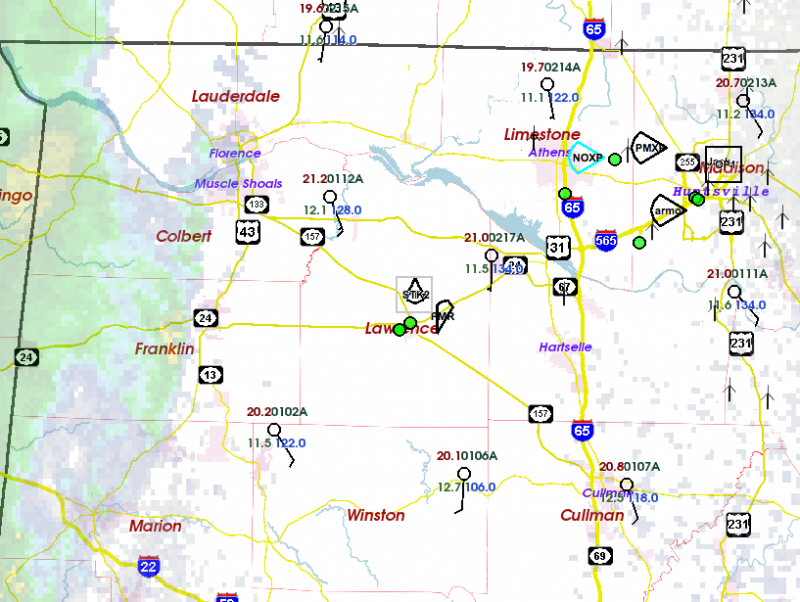STATUS: DOWN
VORTEX-SE has been down for the last week. This is a much-needed break for the researchers, and for me. Right now, there are no hints of significant severe weather in the Southeast for the next few weeks. But eventually the current pattern, with weak flow aloft, will probably break down, and VORTEX-SE will conduct its last IOP for 2017.
Last Wednesday was… well…. special. I think it’s fair to say that the project crews felt that we were finally going to get a data set that included tornadic storms, so the mood in the planning meeting was a lot less gloomy than the last few. I’m not sure how folks feel after spending a whole day, from dawn to dusk, collecting observations of yet another “failure mode” (YAFM). If their thoughts are at all like mine, I’m not sure what to hope for in the remainder of this year’s campaign! I don’t want another significant wave with tornado potential writ large. Been there, done that. Repeatedly. But I don’t want a marginal-looking situation, either. The next IOP will be our last chance, for a while, to observe Southeast storms with multiple-Dopplers, deployable surface instruments, etc.
It’s been rough. Most of the project scientists have been involved in field work where the focus is intercepting tornadoes. Most haven’t really wrapped their heads around how to extract new knowledge from whatever that atmosphere offers up. And the personal costs are high: missed classes, impacts on student learning, making up lectures, families back home, arranging and rearranging travel and accommodations daily, missions that start at 4 AM, and on and on.
There are mission days when we are pretty sure that there won’t be significant tornadoes even though the lead-up looked promising, and there are a few that do seem to have significant tornado potential. Last Wednesday was one of the latter. There was an SPC moderate risk in northern AL, and a high risk further south. The usual tornado forecast parameters were all in place. But the activity in northern AL was benign. The cumulonimbus clouds were fairly vigorous in the lower levels, but in the middle levels they became fuzzy and shredded. Mixing with warm dry air appeared to be evaporating them. Anvils were never solid-looking, but were puffs of ice drifting away from the updraft. Was there too much shear? Too warm and dry aloft? Not enough focus in the lower levels? Something wrong with the hodograph?
 (looking south-southeast from the SWIRLL facility at U. Alabama-Huntsville)
(looking south-southeast from the SWIRLL facility at U. Alabama-Huntsville)
On radar, the echoes were strung out along the strong upper level flow. Those few echoes that had any longevity seemed to be moving into these bands of moistened air. For the most part, the echoes were weak. And another pathology that I have not seen before: the echoes had the shape of cyclonically rotating supercells, but many appeared to have anticyclonic wind shear in the Doppler radar data. The only storm in the domain to produce a research-worthy low-level vortex did not appear to be a supercell on radar, and was perhaps enhanced by terrain effects near Sand Mountain.
I’ve heard a different explanation of this day’s “failure mode” from each meteorologist I’ve talked to. This is all speculation (OK, OK… informed speculation). Once we dig into the rich set of soundings obtained by VORTEX-SE, and perhaps do some computer simulations of the overall setup as well as individual “storms”, we can move from speculation to some more solid information.
This is important. As usual, I believe the forecasters in the NWS forecast offices and the SPC did just about as well as our current understanding allows. Any forecaster (this blogger included) can look at an event in hindsight and “explain” how the forecast went wrong. We can satisfy ourselves that our own comprehension of the situation was better than some other forecaster’s. And the risk here is that our self-confirmed (mis-)understanding of the event becomes the lens through which we look at future events.
But we really have a lot to learn about severe weather forecasting. We do know that when a significant tornado occurs, it is probably in an environment that features a certain mix of CAPE, deep shear, near-ground shear, etc. Our climatologies show this. We have sounding analysis tools based on this understanding. But our climatologies also show us that when that certain mix of conditions is present, a large percentage of the time there will not be significant tornadoes. In other words, in these potent-looking environments, most of the time “something” will reduce tornado potential. In the last 25-30 years we have learned a lot about the conditions present when significant tornadoes happen, but we have learned little about these “somethings” that usually get in the way of tornado production.
It could also be true that our most-used forecast parameters are not the most physically relevant, but instead are only reasonably well-correlated with some yet-to-be-discovered pertinent parameters, so we may be able to improve forecasting by finding more reliable forecast parameters. I was involved in some of the early research to identify the environmental conditions that are present when significant tornadoes occur. And I look forward to the day when researchers can show how my early work was off the mark, and the old ideas can be discarded.
Over time, researchers will probably increase their focus on the “failure modes”, and we will learn to recognize the factors that reduce tornado risk. This may be one of the bigger short-term contributions of VORTEX-SE. We certainly have a rich palette of observed failure modes to study!
Erik
P.S. The psychological and social aspects of this event, and VORTEX-SE in general, are worthy of a lot of blogging. In many ways, they loom a lot larger than the meteorological aspects. I hope I can convince some of my colleagues and VORTEX-SE researchers to share some of their insights and perceptions in this blog someday soon.




